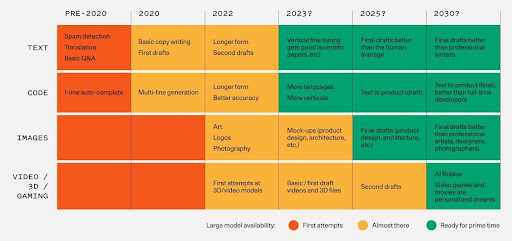We usually see a product as a tangible thing, be it software or hardware. While product managers discover the product’s value, designers give the product its conceptual shape and engineers bring it to life. This is the most basic premise of how products are built.
Few people would question the above statement, but it’s also common knowledge that involving engineering and design in the delivery of an unknown value proposition is risky and expensive. Enter the metric ton of frameworks targeting discovery and agile delivery.
Mitigating risk is fine, but if you think about it, it doesn’t matter how agile you are or how much discovery you’ve done. There is always the risk — sometimes a substantial one — of designing and developing something that dies when it sees the sunlight on the market.
Up until recently, one could only shrug away this unavoidable risk of wasting money and try their best to fail early. A silent revolution has been brewing in the last few years, though. A revolution motivated not just by the will to avoid wasting money, but also to make every single person their own startup — low-code/no-code development.
Table of contents
What is low-code/no-code development?
Low-code/no-code is the name for technologies that enable the delivery of features (or the execution of tasks) otherwise obtainable only through coding.
By no means a novelty in the industry, low-code/no-code can trace its origins all the way back to the first days of the digital era. Operational systems, web browsers, messaging software — all of those processes that used to rely on coding alone turned into an average joe’s tools.
The fundamental difference between the two is how much code is involved in operating said platform or service.
Google translate is no-code — you can translate anything from any language without typing a single command line. Postman, on the other hand, is a low-code platform; it abstracts the majority of the coding, but you still have to make some commands on your own.
Another prime example of a low-code platform is LogRocket. Without much prior knowledge of frontend development, anyone can read page analytics with remarkable detail. Things that could take days to investigate are easily surfaced by LogRocket.
Low-code/no-code for product managers
The fundamental value of low-code/no-code platforms is expanding the delivery power of a niche workforce — aka engineers — to everyone. It’s essentially an economy-of-scale tool for companies that want to either have faster results or free their engineering corp’s schedules so they can dedicate time to more sophisticated challenges.
This is a surface-level analysis, though. I want to dive deeper into the value proposition of those platforms and services for product managers. Although similar, there are two different outlooks we can use to capture all the benefits of low-code/no-code platforms: early-stage and late-stage.
Early-stage: No-code product-market fit
When you’re early in the lifecycle of your product, product-market fit is the only thing on your mind. Whether the company is new or not, product managers need to discover if there’s demand for the value proposition of their product and if there is, how big it is.
Dedicating any amount of time and money to development must be carefully calculated to maximize the chance of survival. Something close to 95 percent of products die in their first year, which means that you most probably won’t get it right the first time. The more you invest in an iteration, the less you have for the coming ones.
Now imagine assembling a team and spending precious time on ideation and development, only to later discover that your product is a bust. There is no amount of agility and a lean mindset that can prevent this train wreck.
Leveraging no-code platforms is the cherry on top of an iterative approach to early-stage product development. A single product manager can build a full feature or service with minimal help from the rest of the company and quickly validate it against potential customers.
In the 95 percent chance of failure, losses are minimal. In the event of the 5 percent success, you struck gold with a small investment. With a quick payback, you can start prioritizing the next iterations to replace the no-code cornerstone, or even build around it instead to leverage growth even more.
Late-stage: Low-code discovery
Late-stage products, especially those that have remained within the product-market fit for some time, tend to have a harder time iterating. Legacy drags the team down to a halt as a lot of moving parts generate bugs, expedite priorities, and the whole process of ideation and delivery is considerably harder.
The team is almost always understaffed and the build trap is a common reality among late-stage products. Product managers that see themselves in this situation find it hard to prioritize discoveries that depend on engineering or design, often resorting to low-risk deliveries as a rule or simply building what they are told.
Low-code platforms are by no means a savior sent by the heavens but are indeed a very welcome breath-of-fresh-air for those product managers that wish to try out something new. Who knows, maybe they can discover a real impact for their businesses — one that colleagues cannot turn a blind eye to when the time comes to officially produce it.
If money was the main constraint leading product managers to leverage no-code platforms as a means for discovery during early stages, and during late-stage product development, the problem is time and focus.
Asking your team to drop everything and build something that serves only to test a hypothesis is something that will make your tech lead laugh in your face. Asking for one afternoon of an engineer to make a Postman call, on the other hand, is way more palatable.
Whether it’s early- or late-stage, low-code/no-code platforms provide product managers with something that our position naturally lacks: freedom to deliver. By not depending on anyone else (or depending slightly), we can test hypotheses pretty cheaply and make prioritizations with a higher degree of confidence.
When low-code/no-code doesn’t work
That’s it then? Let’s fire all the engineers and let’s all use low-code/no-code platforms from now on? Evidently not.
Subscribe to our product management newsletter
Get articles like this to your inbox
All those platforms are businesses on their own behalf, which means that they don’t exist out of charity — they need to make a buck for a living. To be profitable, those platforms tend to target the biggest and most frequent use cases possible to make the most sales.
“The devil lives in the details” as some folk would say, and that’s precisely where low-code/no-code platforms start to lose ground in favor of a more traditional approach to software development.
The more a business scales, the more peculiarities it collects along the way. The exercise of becoming its own thing and creating differentiation from the competition also takes away some of the value that a “one-size-fits-all” approach can deliver.
Furthermore, low-code/no-code platforms charge a lot to keep operations up. The more personalized a service you need, the more they charge you. As the product grows, the less it leverages standardized platforms.
There are thousands of examples around the globe of products that started based on a no-code or low-code platform and eventually verticalized out of need. So much so that it’s hard to pinpoint a universal example that talks to a broader audience. Let’s come up with a silly story to serve as an illustration then:
Deedee and a friend came up with this new idea where they would sell personalized t-shirts for bachelor and bachelorette parties.
Having no significant technical skills and no money to hire someone that does, Deedee had no option other than to build everything using low-code and no-code tools.
The web store was powered by Shopify.
There was an Instagram account to find leads and promote the brand.
Shirts would be printed on demand using Printify.
Marketing and overall customer communication was done through Braze.
Everything was integrated using Zapier.
Deedee and friend had no clue that you could set up an entire e-commerce operation using only five platforms. How come more people don’t do the same and get rich like them?
Five months in, sales are booming, but problems are also:
- Shopify doesn’t work with a payment method available only in their home state
- Instagram is costing a fortune every month
- Printify is eating away most of their margin now that production grew
- Braze is talking something about “whitelabel domains”
- Zapier became a mess as the business grew and more integrations were done
Deedee’s friend has been talking about hiring some people with coding and design experience in e-commerce, but Deedee was reluctant. When they had their first month with a net loss despite the increase in sales, Deedee gave in and hired two people fresh from college.
At the end of that same year, they were launching their first core service called “tank-top” to reduce the dependency on third-party providers.
Their business has been growing ever since. So much, in fact, that the other day an intern mentioned that they could use this new tool called ChatGPT to help them with customer support.
Conclusion
Low-code/no-code platforms are a game-changer for starting businesses or performing discovery out of a product’s area of knowledge. As with many external economies of scale before them, low-code/no-code empowers people to do more while spending less time, know-how, or even money.
They are not a silver bullet, though. Low-code/no-code tools have a rather low ceiling when it comes to personalization capabilities and cost-effectiveness. As the product scales, the more expensive and limited they become, which, in turn, makes it all the more interesting to develop an alternative of your own in-house.
Featured image source: IconScout
Source link







Leave a Reply